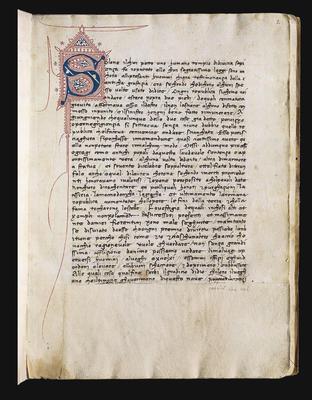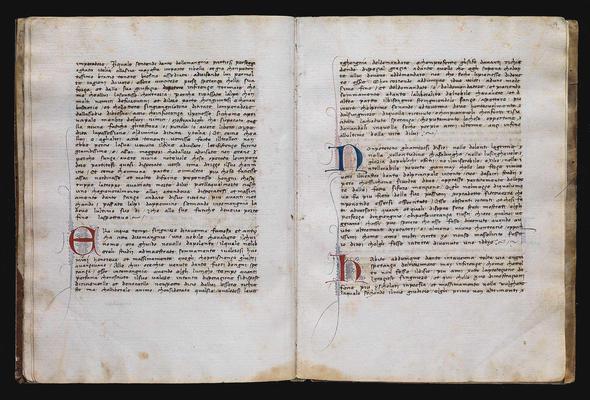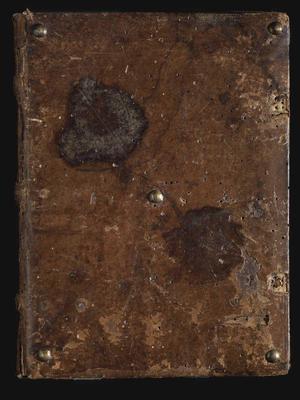Giovanni Boccaccio
Trattatello in laude di Dante.
Decorated manuscript on paper. Florence, first half of the fifteenth century.293x218 mm.ii+30 leaves. Complete. Three regular quires. Collation: 1-310. The first and last leaves blanks. Modern pencilled foliation in the upper right corner. Text block: 180x143 mm, one column, 34-36 lines, first line above top line. Ruled in plummet. Catchwords in the centre of the lower margin of some leaves. Text written in brown ink, a regular gothic mercantesca cursive. The verso of the first and the second flyleaves in cursive in a sixteenth-century hand, containing three exorcism prayers and the Benediction of animals. Thirty-one four-line initials alternately of red or blue with contrast flourishing; on fol. 1r a six-line blue initial with gabled frame and ground of red and blue pen-work. Contemporary brown calf over wooden boards, diagonally ruled in blind, five brass bosses on the upper and lower covers. Spine with three raised bands, vellum pastedowns. Upper cover stained, some rubbing and worming, upper joint split at the foot, lacking clasps. Modern black morocco box. A very well preserved manuscript, repair to the lower margin of fol. 2 affecting a few letters. A tear at the lower margin of fol. 25, insignificant old repair in the gutter of fol. 26. Edges darkened. On fol. Ir the inked note ‘Boccaccio. Vita di Dante Alighieri (stampata più volte)', possibly in a nineteenth-century hand, and the later pencilled annotation ‘Boccaccio Giovanni s.xiv'.
Provenance: Giannalisa Feltrinelli (1903-1981; ex-libris on the front pastedown; Christie's, The GiannalisaFeltrinelli Library. Partii. Italian Renaissance Manuscripts and Autograph Letters, London, 3 December 1997, lot139); Livio Ambrogio collection.
A very fine manuscript, in its original binding, containing the first full-length biography of Dante, the first biographical treatment of any ‘modern' author, an innovative work written in the vernacular that had a lasting influence on the genre of the literary vita. In his biography Boccaccio combines motifs from both classical and medieval traditions, following the model of the Vitae Vergili circulating in the Middle Ages, and in particular those by Donatus and Servius, as a way of identifying Dante as the new Virgil. He describes Dante's ancestry, his studies, the relationships with Beatrice and Gemma Donati, his political career and exile, his death, and concludes with an invective against the ungrateful city of Florence. Boccaccio's physiognomical description of Dante's appearance is famous. The chronology of the biographical information which he gives is somewhat uncertain, and there are numerous legendary details. Yet the work is in effect a ‘verbal monument' raised in homage to Dante, responsible in Boccaccio's opinion for the rebirth of poetry in Italy; at the same time the text can be seen as a political attack on Florence for having sent this outstanding native into exile. The composition of the work seems to have been stimulated by Boccaccio's first meeting with Petrarch when the latter visited Florence in 1350. In March 1351 Boccaccio in his turn paid Petrarch a visit in Padua, where the two writers discussed the value of Dante's work. Having learned that Petrarch did not possess a copy of the Commedia, Boccaccio sent him, between 1351 and 1353, the work (today in the Vatican Library,msVat. Lat. 3199). These are the circumstances in which Boccaccio's plan to write a biography of Dante in the vernacular, recounting the life of the supremeFlorentine poet.
Of the work three different redactions are known, dated 1351-1355, early 1360s, and early 1370s. This manuscript belongs to the group containing the first and longer redaction, derived from the original autograph preserved in the Biblioteca Capitolar in Toledo (ms Zelada 104.6). Of this first version about fifty manuscripts are recorded, the majority of which were copied in Florence over the course of the fifteenth century.




